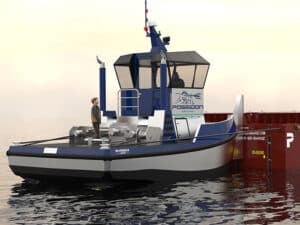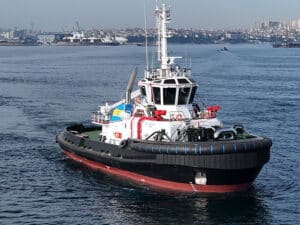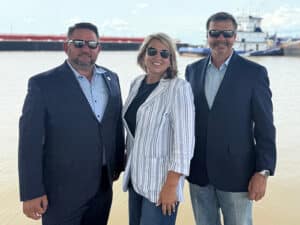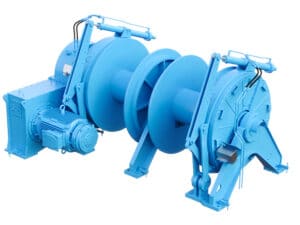
Fishing vessel grounded after captain left wheelhouse unattended
Written by Nick Blenkey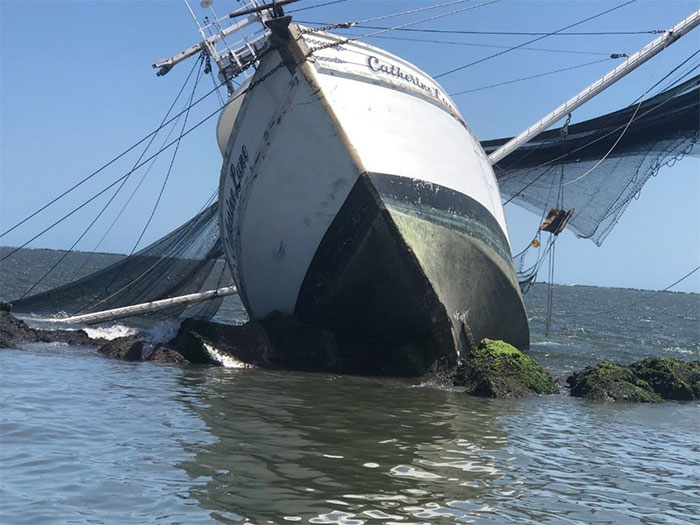
The fishing boat broke up subsequent to the grounding [USCG photograph]
A captain’s decision to leave the wheelhouse of a fishing vessel unattended while on autopilot t led to the vessel’s grounding and sinking, says the National Transportation Safety Board in a marine investigation report released Tuesday.
On June 9, 2021, about 9.15 a.m local time, the fishing vessel Sage Catherine Lane was transiting outbound om the St. Marys River, south of Cumberland Island, Ga., when it grounded on the north jetty of the St. Marys Entrance channel. After the vessel began to flood, the three-person crew abandoned it and were rescued by a nearby Good Samaritan vessel. The Sage Catherine Lane later sank with about 2,300 gallons of fuel, engine oil and hydraulic oil on board. A crewmember sustained a minor injury.
As the vessel was transiting outbound, the captain set the vessel’s autopilot to maintain the vessel’s heading out of the inlet. He answered a phone call and left the wheelhouse. Shortly after, he felt the vessel turn abruptly to port. He returned to the wheelhouse and attempted to turn away from the jetty, but the Sage Catherine Lane struck the jetty and grounded.
$1 MILLION TOTAL LOSS
The vessel broke apart and sank following a thunderstorm three days after the grounding.
It was declared a total loss at $1 million.
PRIOR PROBLEMS WITH AUTOPILOT
Two days before the grounding, on June 7, the casualty captain was transiting aboard the Sage Catherine Lane on the Matanzas River to St. Augustine, Fla, to unload shrimp. The captain had the autopilot engaged. When he pressed the standby button to shift to hand steering the vessel, the autopilot did not switch into standby mode and release helm control to the captain (in standby mode, the autopilot system is powered on but not engaged). To regain steering control, the captain unplugged the autopilot. After the fishing vessel docked, the captain examined the autopilot system and noted that the rudder post was contacting the autopilot rudder angle sensor, causing the autopilot’s rudder angle indicator lever to bend. The captain also noted that the autopilot rudder angle sensor was loosely mounted, which caused the autopilot system rudder angle input to be 4–5° off from the actual rudder angle. The captain straightened the autopilot rudder angle indicator lever, remounted the rudder angle sensor, and secured it in place with plastic zip ties. The captain informed the vessel’s manager of the problems with the autopilot system and his actions to correct them. The vessel manager and captain decided that the system was fixed and there was no need to have a technician evaluate the autopilot system or replace it.
The Sage Catherine Lane departed St. Augustine on June 7 at 2030 and headed to engage in shrimping just offshore Amelia Island. During this transit, the autopilot operated with no issues, and it properly released the helm to the captain when he pushed the standby button to disengage the autopilot. After catching 900 pounds of shrimp, the vessel entered the St. Marys River with the autopilot engaged and anchored in Cumberland Sound on June 8 at 9.00 p.m. with no problems.
However, the vessel’s reported sharp turn to port (about 90°) while transiting outbound on autopilot on the following day indicated that the system failed. The sudden sharp turn likely resulted from the helm/autopilot receiving a signal that the vessel was far from its programmed heading and required significant rudder correction to return to the original heading. Based on the information provided to investigators (due to the sinking, a postcasualty exam was not possible), this sudden change could have been caused by the loosening or detachment of the autopilot rudder angle sensor, which resulted in the transmission of incorrect rudder position data to the autopilot that subsequently commanded a large port rudder angle.
“Leaving the wheelhouse unattended is imprudent, especially when navigating areas like the St. Marys Entrance, which included a narrow navigation channel, two jetties and vessel traffic,” the report said. “Had the captain stayed in the wheelhouse after engaging the autopilot, he would have been able to respond and take control of the vessel after the autopilot system failed and caused the rudder to turn to port.”
PROBABLE CAUSE
The NTSB determined the probable cause of the grounding of the fishing vessel was the captain’s decision to leave the wheelhouse unattended as the vessel transited the St. Marys Entrance on autopilot, leaving insufficient time to respond when the autopilot failed and caused the vessel to go off the set course.
“Autopilot use does not relieve the operator of responsibility to conduct a proper navigation watch. Use of autopilot should not be a justification for an operator to leave the wheelhouse or bridge unattended in confined waters,” the report said. “Navigating in channels and harbors requires quicker reaction times due to traffic, currents encountered, and frequent course changes, and more rudder due to slower speeds. Therefore, autopilot use is often discouraged or prohibited in a harbor entrance or narrow channel.”

